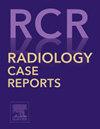Rare triad of anomalous biliary anatomy (pancreaticobiliary maljunction), choledochal cyst and cholangiocarcinoma in a 45-year-old white male: A case report
Q4 Medicine
引用次数: 0
Abstract
Pancreaticobiliary maljunction (PBM) is a congenital anomaly where the pancreatic and bile ducts join outside the duodenal wall, resulting in formation of an elongated common channel. In normal physiology, the sphincter of Oddi regulates the junction between the pancreatic and bile ducts. Individuals with PBM lack this regulatory mechanism resulting in reflux of pancreatic juices into the biliary tract. Activated pancreatic enzymes result in chronic inflammation of biliary tract resulting in choledochal cysts which places patients at risk for eventual development of cholangiocarcinoma.
A 45-year-old white male presented with jaundice and dark urine. Laboratory tests showed elevated liver enzymes and bilirubin. Diagnostic imaging revealed anomalous biliary anatomy, a Type 1A choledochal cyst, and a mass in the common hepatic duct. Extrahepatic cholangiocarcinoma was confirmed by ERCP and biopsy, with PET/CT indicating localized disease without distant metastases.
Treatment included a biliary sphincterotomy, stone drainage, and stenting. The patient underwent a robotic-assisted bile duct resection, cholecystectomy, hepatic lobectomy, and Roux-en-Y hepaticojejunostomy. The surgical specimen showed an invasive, poorly differentiated adenosquamous carcinoma with perineural invasion, but no regional lymph node involvement.
PBM is a rare condition, and its diagnosis and management necessitate a multidisciplinary team, including pancreaticobiliary surgeons, endoscopists, and radiologists. Accurate diagnosis hinges on the team's expertise. Radiologists must be aware of PBM and have a thorough understanding of the associated anatomy and imaging characteristics that may indicate high-risk dysplasia or malignancy.
一名 45 岁的白人男性罕见地同时患有胆道解剖异常(胰胆连接异常)、胆总管囊肿和胆管癌:病例报告
胰胆管连接不良(PBM)是一种先天性畸形,胰管和胆管在十二指肠壁外连接,形成一条拉长的共同通道。在正常生理情况下,Oddi括约肌调节胰管和胆管之间的连接。PBM 患者缺乏这种调节机制,导致胰液反流到胆道。活化的胰酶导致胆道慢性炎症,从而形成胆总管囊肿,使患者面临最终发展为胆管癌的风险。一名 45 岁的白人男性出现黄疸和深色尿液。实验室检查显示肝酶和胆红素升高。诊断性造影显示胆道解剖异常、1A 型胆总管囊肿和肝总管肿块。肝外胆管癌经ERCP和活检证实,PET/CT显示为局部病变,无远处转移。患者接受了机器人辅助胆管切除术、胆囊切除术、肝叶切除术和Roux-en-Y肝空肠吻合术。手术标本显示为浸润性、分化较差的腺鳞癌,有神经周围浸润,但没有区域淋巴结受累。PBM是一种罕见疾病,其诊断和治疗需要一个多学科团队,包括胰胆外科医生、内镜医师和放射科医师。准确的诊断取决于团队的专业知识。放射科医生必须了解 PBM,并透彻理解相关的解剖和成像特征,这些特征可能预示着高风险的发育不良或恶性肿瘤。
本文章由计算机程序翻译,如有差异,请以英文原文为准。
求助全文
约1分钟内获得全文
求助全文
来源期刊

Radiology Case Reports
Medicine-Radiology, Nuclear Medicine and Imaging
CiteScore
1.10
自引率
0.00%
发文量
1074
审稿时长
30 days
期刊介绍:
The content of this journal is exclusively case reports that feature diagnostic imaging. Categories in which case reports can be placed include the musculoskeletal system, spine, central nervous system, head and neck, cardiovascular, chest, gastrointestinal, genitourinary, multisystem, pediatric, emergency, women''s imaging, oncologic, normal variants, medical devices, foreign bodies, interventional radiology, nuclear medicine, molecular imaging, ultrasonography, imaging artifacts, forensic, anthropological, and medical-legal. Articles must be well-documented and include a review of the appropriate literature.
 求助内容:
求助内容: 应助结果提醒方式:
应助结果提醒方式:


